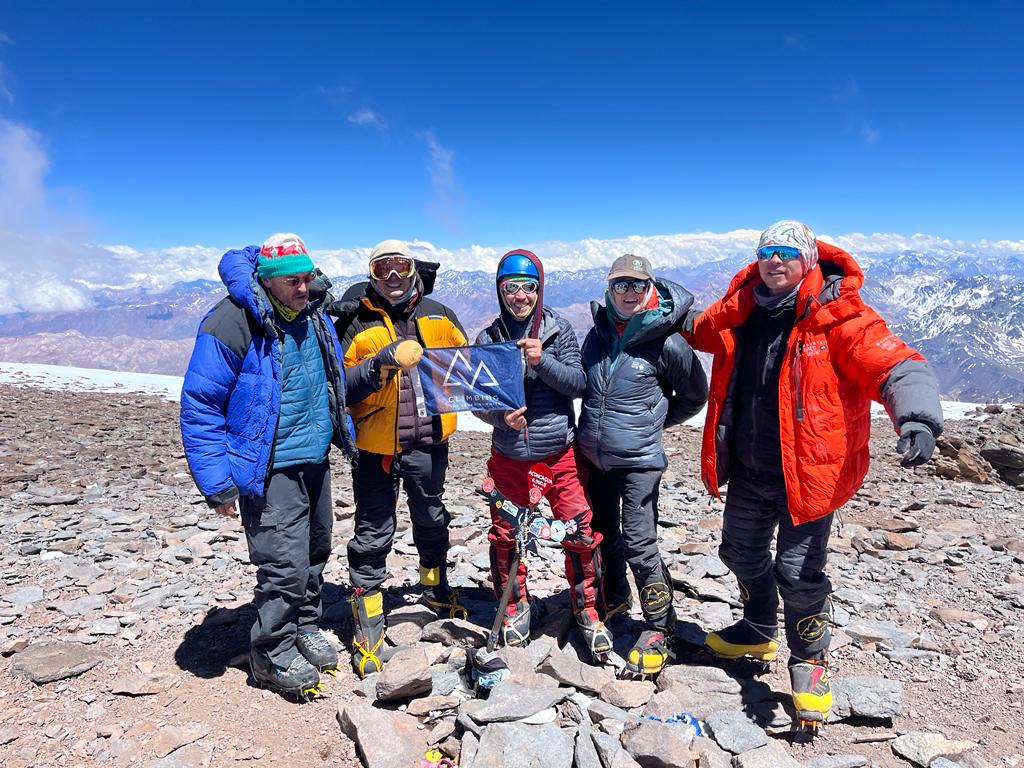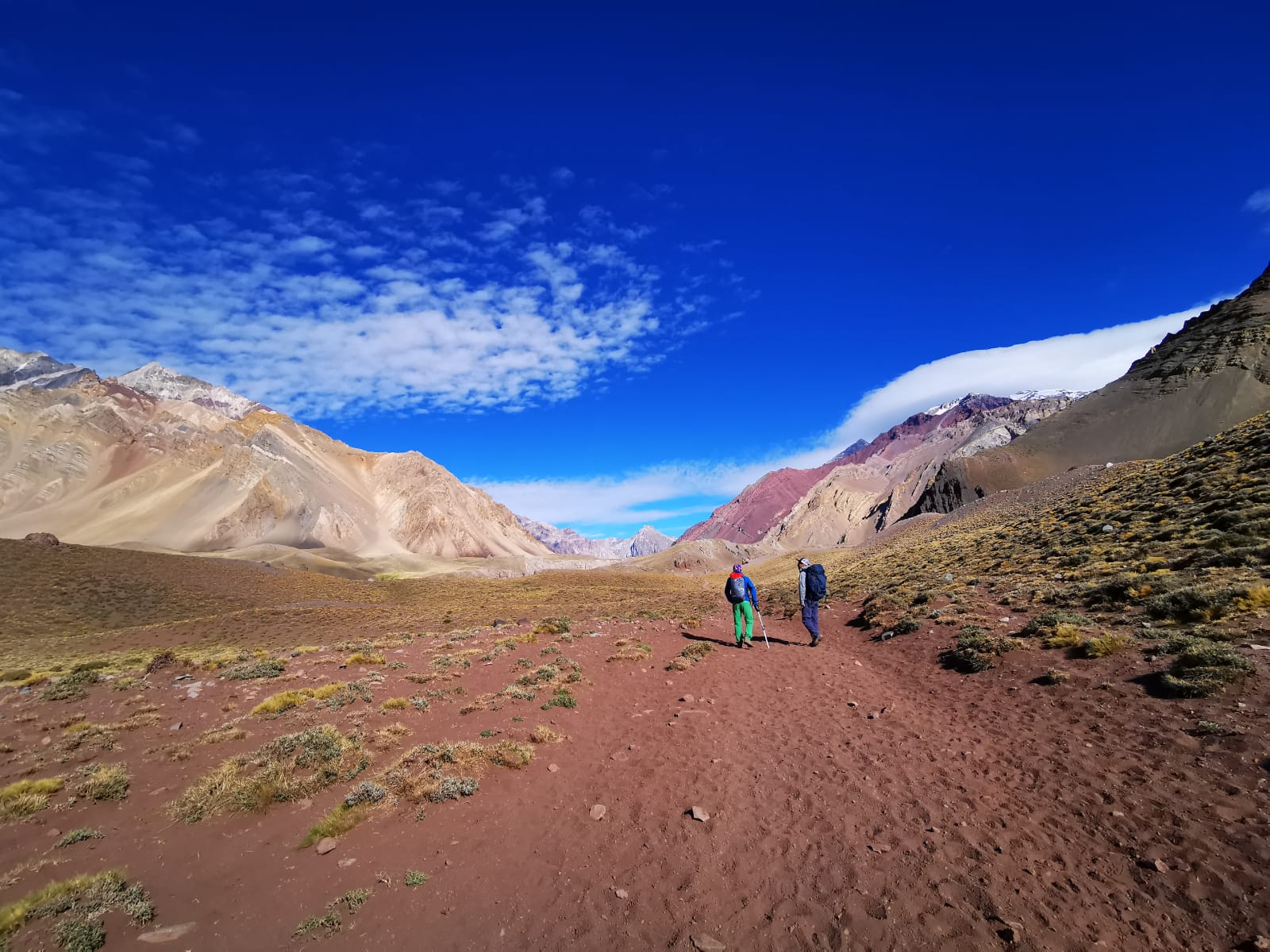Elevation: 6,962m or 22,8410ft
Duration: 15 to 21 Days
Continent: South America
Route: False Polish Traverse
Difficulty: Intermediate
Route Choice
We favour the 360 False Polish Traverse route, which traverses the mountain by going from Plaza Argentina up and over to Plaza de Mulas, and most of our team departures follow that route.
We find people really enjoy this option as the days are more manageable, the scenery is better, and water sources are more stable. It also avoids some of the more crowded camps and it’s pretty cool to go in one way and out the other and see the whole peak.

The descent is also easier as it cuts a day off the trek back to the trailhead. Last but not least, our Vacas Valley approach enjoys much earlier light, so it’s a bit warmer and more hospitable than the “Normal” Horcones Valley route.
CTSS teams gather in Mendoza to run through gear checks and briefings, acquire climbing permits, and go out to dinner as a team.
From Mendoza, we will travel to Penitentes, our last staging point by the trailhead, where we will organize mule loads to start our trek the following morning.
We spend three days trekking into base camp carrying only day packs as this leg of the expedition is supported by mules who help carry our trekking duffels to camp each day for us. Our base camp duffels are sent directly ahead and meet us at Plaza Argentina Base Camp for our climb.
Once we arrive at base camp, we will employ a double-carry acclimatization strategy, which involves carrying and caching our gear before sleeping low and moving up the next day. We use three camps above base camp and maintain our high camp as we go for the summit.
Summit day is long, cold, physical, and at a very high altitude. The summit route is not very technical but demands excellent fitness and solid cramponing technique on moderately steep terrain. The summit route can be snow right out of high camp or only a little snow just below the summit, depending on the year and snow accumulation.
From our high camp, we drop down the other side of the mountain, connecting via the ‘Normal Route’ to Plaza de Mulas Base Camp, thus completing the traverse.
We then pack up, wave goodbye to the mountain and trek back out to the trailhead for a late transport back to Mendoza the same evening.
How to Climb Aconcagua
Which Route is the Best?
Aconcagua Beta
Physical preparation is key for Aconcagua. Even if you plan on hiring porters you should be in the best mountaineering shape of your life for this expedition. No matter what you read on other websites about “trekking” this peak, make no mistake: Aconcagua is a mountaineering challenge that requires you to carry a heavy pack uphill at high altitudes day after day. Train as if you’re heading to Denali then enjoy the climb rather than suffer through it!
For an expedition as long and strenuous as Aconcagua we highly recommend purchasing your gear rather than renting. Properly fitting and breaking in your boots, pack and other big-ticket items is extremely important. Additionally, having every little item already secured and packed will make your time in Mendoza much more relaxed and ensure you’re fully ready for the trip.
If an airline loses bags or there is a major gear malfunction there are a few rental and mountaineering gear shops in Mendoza. During the busy Aconcagua season sizes and availability are not guaranteed. Your guide can help point you in the right direction if this situation arises.
Terms to know for Aconcagua
- Plaza Argentina - Our base camp for the ascent. Located on the east side of the mountain, we trek into Plaza Argentina before leaving the base camp to traverse the mountain, summit and descend into a different base camp.
- Plaza de Mulas - Base camp on the descent located on the west side of the mountain and also base camp for other climbing teams using the 'Normal Route' rather than the 360 Traverse route. We will descend to Plaza de Mulas after our summit bid and stay for one night before finishing the hike out to the road.
- Vacas Valley - Pronounced “Bacas Valley,” this is our route for the trek in. We start at the terminus of the Vacas and trek two days up the valley before taking a side corridor up to Plaza Argentina on the third day of the trek.
- Horcones Valley - Plaza de Mulas is located at the head of the Horcones Valley. On our descent and trek out we will follow the Horcones River through the valley from Plaza de Mulas down to the road, a distance of about 18 miles (29 kilometers).
- Double Carry - A technique for acclimatization and carrying the large amount of gear we need to support our expedition. Double carries mean two trips to each camp. For example, we will pack all our extra food and any gear we don’t need at the moment into our packs, ascend from Plaza Argentina to Camp 1, cache our gear at Camp 1, then return to base camp the same afternoon to sleep low. The next day all remaining gear goes in our packs and we re-ascend to Camp 1, staying there and leaving Plaza Argentina behind. Repeat for Camp 1 to Camp 2, and Camp 2 to Camp 3. We will do a single carry with all gear down from Camp 3 to Plaza de Mulas after summit day.

What is a Double Carry?
